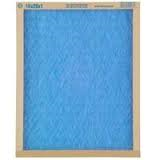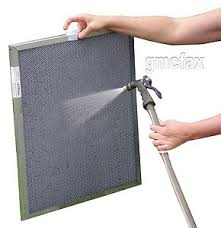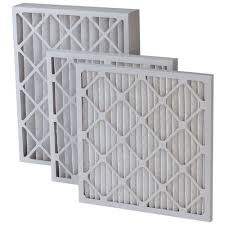All too often consumers do not know what air filter is the correct one to use in their home. How could anyone blame them? Furnace filters available on the market today come in a wide variety and in a wide range in cost, quality, and size. Some look very basic, while others have fancy labels that say HEPA or ALLERGEN. I am going to break down how air filters are rated on the minimum efficiency reporting value (MERV) scale, what is the MERV scale, the different types of air filters, what to watch for, and give you better understanding of furnace filters in general. SO when you are choosing your next air filter, you’ll be able to choose wisely.
What is the MERV scale?
To measure the efficiency of furnace air filters installed in duct work, the American Society of Heating, Refrigerating and Air-Conditioning Engineers (ASHRAE) has a rating system called the minimum efficiency reporting value (MERV). These ratings range from 1 (lowest) to 20 (highest), and shows three things:
- the ability of the air filter to remove particles
- the ability of the air filter to resist airflow
- the product’s expected operating life
MERV | Min. particle size | Typical controlled contaminant | Typical Application |
| 1–4 | > 10.0 μm | Pollen, dust mites, cockroach debris, sanding dust, spray paint dust, textile fibers, carpet fibers | Residential window AC units |
| 5–8 | 10.0–3.0 μm | Mold, spores, dust mite debris, cat and dog dander, hair spray, fabric protector, dusting aids, pudding mix | Better residential, general commercial, industrial workspaces |
| 9–12 | 3.0–1.0 μm | Legionella, Humidifier dust, Lead dust, Milled flour, Auto emission particulates, Nebulizer droplets | Superior residential, better commercial, hospital laboratories |
| 13–16 | 1.0–0.3 μm | Bacteria, droplet nuclei (sneeze), cooking oil, most smoke and insecticide dust, most face powder, most paint pigments | hospital & general surgery |
| 17–20 | < 0.3 μm | Virus, carbon dust, sea salt, smoke | Electronics & pharmaceutical manufacturing cleanroom |
Types of Furnace Air Filters.
The two most common air filters we see in furnaces that have a rating between 1-4 are the fiberglass and washable filters.
Disposable Fiberglass Filters

- Usually carrying ratings of 1 to 4, flat-paneled fiberglass air filters consist of a disposable filter made of layered fiberglass fibers (the blue photo to the right).
- These fairly inexpensive air filters provide protection for heating and cooling components and are not used for cleaning the air in your home.
- The filters have a medium efficiency rating for capturing larger airborne particles and a low efficiency for filtering dust mites, viruses, bacteria and dander.
Permanent Washable Furnace Air Filters

- Permanent and washable filters are fabricated using plastic or metal frames.
- These furnace filters have a few layers of polypropylene weave or wire mesh material that stops certain pollutants. The durability of the filtration material makes it fairly easy to clean and, if cleaned occasionally, are reusable.
- They’re usually rated only 1 to 4 on the MERV scale.
Pleated Polyester Furnace Air Filters
 Disposable pleated polyester filters have a sizable surface field and a rating of 5 to 13 on the MERV scale.
Disposable pleated polyester filters have a sizable surface field and a rating of 5 to 13 on the MERV scale.- The medium efficiency rating makes them efficient at filtering small to large particles from the air in your home. Filters with a rating of 7 to 13 provide a level of effectiveness when compared to absolute high-efficiency particulate air (HEPA) filters, but you can find these in the store at a lower price point.
- They also have less airflow resistance compared to HEPA filters and support quieter operation of the blower fan in your furnace.
- Pleated filters also come in higher efficiency models with a rating of 14 to 16. They have the physical appearance of true HEPA filters and are often confused with HEPA products.
HEPA Furnace Air Filters
 HEPA filters are recognized by the OSHA & EPA as the ultimate product for cleansing airborne particles.
HEPA filters are recognized by the OSHA & EPA as the ultimate product for cleansing airborne particles.- HEPA products filter air at a very fine level, blocking elements that are 0.3 microns or larger. These filters catch 99.97 percent of all particles.
- HEPA filters have an efficiency rating of 17 to 20. Most residential heating and cooling systems can’t accommodate HEPA filters because of the product’s dimensions and resistance to airflow.
- Switching to HEPA filters will significantly improve indoor air quality, but if you have an older furnace, switching to the HEPA filter may require calling a heating and cooling professional to retrofit the furnace.
Note: Most HEPA and Allergen filters do not allow enough air flow which starves your furnace of air and potentially reducing the life of the furnace. You can find Pleated Polyester Filters with MERV rating as high as HEPA filters but for half the cost. In your owners manual that came with your furnace it should specify what furnace filter on the MERV scale to use.
How Often Should Furnace Air Filters Be Changed?
- It may sound obvious, but basically air filters for your furnace should be changed when they are dirty.
- The frequency in which they get dirty and require changing depends on the living condition in the home, the type of filters used, and how often and how heavily your HVAC equipment is used.
- A good rule of thumb is check them once a month and if they appear dirty, change the filter.
Now that we covered some of the different types of filters here is Healthy Living Air Duct Cleanings recommendations when choosing an air filter.
Always refer to the owners manual that came with the furnace to see what the manufacturer’s recommendation is when choosing an air filter. If the owners manual is not available you could always search online for a copy of your owners manual online, or call the manufacturer.
Most HEPA and Allergen rated filters do not allow for efficient air flow for your furnace.
Healthy Living Air Duct Cleaning recommends a Pleated Polyester Filter. The medium efficiency rating makes them efficient at filtering small to large particles. Filters with a rating of 7 to 13 provide a level of effectiveness compatible with absolute high-efficiency particulate air (HEPA) filters, but at a lower price point.

